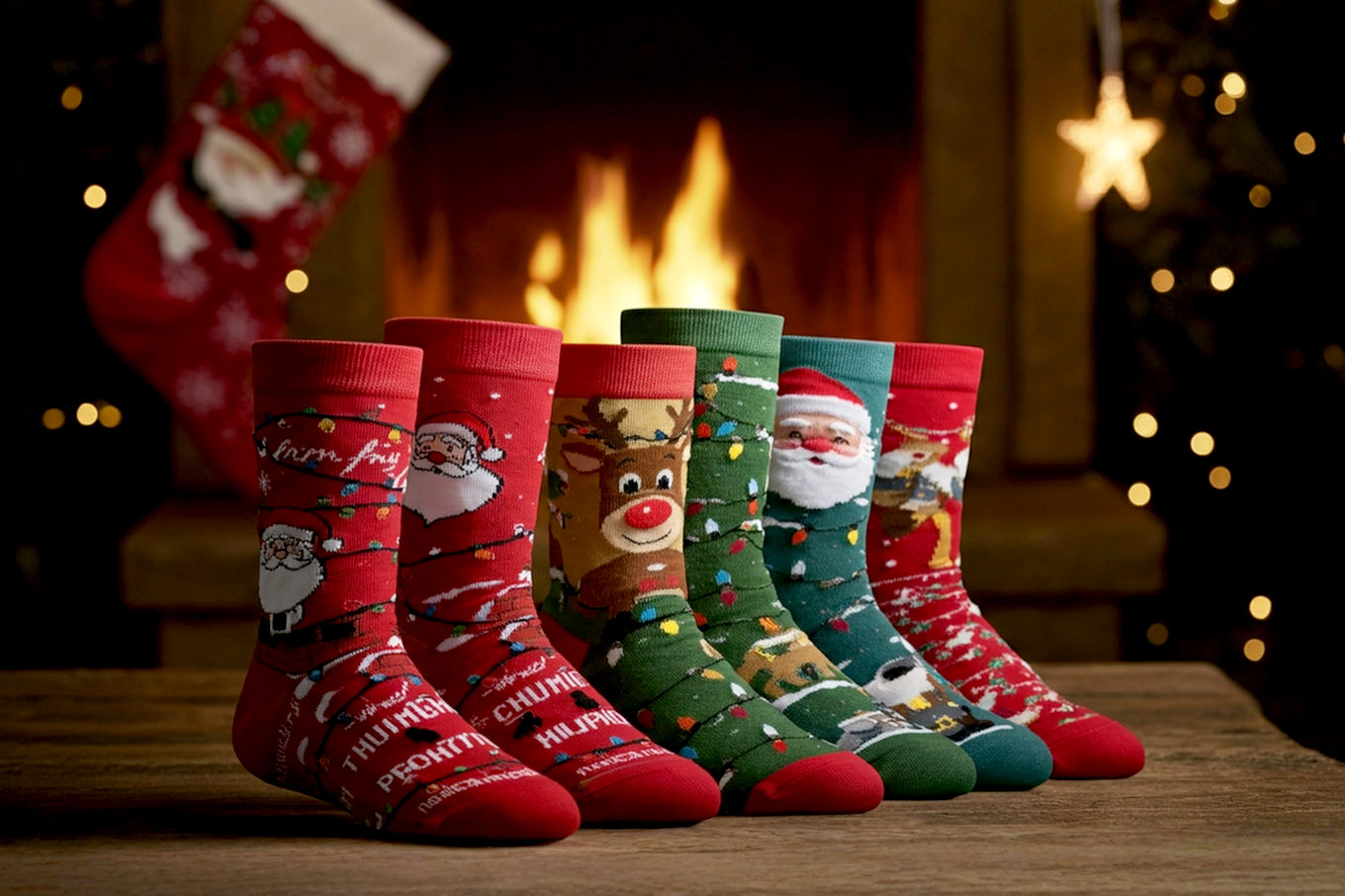This post may contain affiliate links. If you make a purchase through these links, we may earn a commission at no additional cost to you.
In a world increasingly dominated by fleeting digital messages and instant communication, there’s something profoundly special about receiving a physical Christmas card. It’s more than just a piece of paper; it’s a tangible connection, a warm embrace delivered right to your mailbox. Classic Christmas cards, with their familiar imagery and heartfelt sentiments, hold a unique place in our holiday traditions. They possess a timeless charm that seems to defy the rapid pace of modern life, offering a comforting link to the past and a genuine expression of care.
This article will explore the deep-rooted reasons behind the enduring appeal of classic Christmas cards. We’ll delve into their fascinating history, uncover the emotional and psychological resonance they hold, appreciate the aesthetic allure of their designs, and understand the cherished rituals they represent. By the end, you’ll see why these humble greetings continue to captivate our hearts and remain an indispensable part of the festive season.
A Journey Through Time: The History and Evolution of Christmas Cards
The tradition of sending Christmas cards is relatively young compared to other holiday customs, but its growth was rapid and its impact profound. Understanding its origins helps us appreciate the foundation of its lasting appeal.
The Genesis of a Tradition: Early Victorian Beginnings
The story of the modern Christmas card begins in England, specifically in 1843, thanks to Sir Henry Cole. Cole, a prominent civil servant and inventor, found himself overwhelmed with correspondence during the holiday season. He wanted a quick, polite way to send festive greetings to his friends and acquaintances without writing lengthy letters to each. He commissioned artist John Callcott Horsley to design a card that could be mass-produced.
Horsley’s design featured three panels: a central image of a family enjoying a Christmas feast, flanked by scenes of people helping the poor. The card bore the simple greeting, “A Merry Christmas and a Happy New Year to You.” About 1,000 copies were printed and sold for one shilling each, a considerable sum at the time. While not an instant sensation, Cole’s innovative idea planted the seed for a global tradition.
A crucial factor in the card’s eventual success was the introduction of the Penny Post in 1840. This postal reform allowed letters and cards to be sent anywhere in the United Kingdom for a single penny, making communication affordable for the masses. Without the Penny Post, the widespread adoption of Christmas cards would have been impossible. The ability to send a standardized, inexpensive greeting across distances was revolutionary.
The Golden Age: Late 19th and Early 20th Century Flourish
The true explosion in popularity for Christmas cards occurred in the latter half of the 19th century, ushering in what many consider the Golden Age of Christmas card design. This period was heavily influenced by advancements in printing technology, particularly lithography and chromolithography.
Lithography, a printing method based on the repulsion of oil and water, allowed for much more detailed and intricate designs than earlier methods. Chromolithography, an extension of lithography, enabled the reproduction of vibrant, multi-color images. These technologies made it possible to produce beautiful, affordable cards on a large scale, bringing artistry into the homes of ordinary people.
During this era, a wide array of themes became popular. Winter scenes depicting snowy landscapes, cozy cottages, and ice skaters were common, reflecting the romanticized view of the season. Religious imagery, including Nativity scenes and angels, remained central, emphasizing the spiritual aspect of Christmas. Festive gatherings, children playing, and anthropomorphic animals also appeared frequently, adding a touch of whimsy and warmth. Publishers like Louis Prang in the United States, often credited with popularizing Christmas cards in America, produced millions of cards, each a small work of art.
Mid-Century Modern and Beyond: Adapting to Changing Tastes
As the 20th century progressed, Christmas card designs continued to evolve, reflecting broader artistic and social changes. The mid-century modern aesthetic, characterized by clean lines, bold colors, and simplified forms, influenced card designs from the 1940s through the 1960s. These cards often featured stylized illustrations of Santa, reindeer, or abstract holiday patterns, moving away from the more ornate Victorian styles.
The two World Wars also left their mark. During these periods, cards often carried patriotic themes, featuring soldiers or symbols of national pride. Scarcity of materials sometimes led to simpler designs. Post-war prosperity and the rise of photography led to another significant shift: the personalized Christmas card. Families began incorporating their own photographs into cards, a trend that continues to be immensely popular today, offering a unique blend of personal touch and traditional greeting. This evolution shows the adaptability of the Christmas card, allowing it to remain relevant while retaining its core purpose.
The Heart of the Matter: Emotional and Psychological Resonance
Beyond their visual appeal and historical roots, classic Christmas cards resonate deeply with us on an emotional and psychological level. They tap into fundamental human needs for connection, memory, and tangible expression.
Nostalgia: A Warm Embrace from the Past
One of the most powerful elements of classic Christmas cards is their ability to evoke nostalgia. These cards often feature imagery and sentiments that connect us with simpler, perhaps idealized, times. Seeing a classic illustration of a horse-drawn sleigh or a Victorian caroler can transport us back to childhood memories, family traditions, or even a romanticized version of Christmas history.
This feeling of nostalgia isn’t just about remembering the past; it’s about reconnecting with the emotions associated with those memories. It’s a warm embrace from the past, reminding us of cherished moments and the continuity of holiday traditions. The familiar designs and timeless messages act as triggers, bringing forth feelings of comfort, joy, and belonging. In a fast-paced world, this pause for nostalgic reflection can be incredibly comforting and grounding.
Tangibility in a Digital World: The Physical Connection
In an age dominated by emails, texts, and social media posts, the tangibility of a physical Christmas card stands out. There’s a distinct sensory experience involved: the feel of the card stock, the sight of the printed image, and sometimes even the faint scent of the paper or ink. This physical presence makes the message feel more substantial and deliberate.
Unlike a fleeting digital message that can be scrolled past and forgotten, a physical card requires effort to open and hold. It’s a deliberate act of connection, a conscious choice to send something real and lasting. Many people display their received Christmas cards, turning them into temporary seasonal decor that brightens their homes and serves as a constant reminder of loved ones. This act of display further reinforces the card’s tangible value and its role in creating a festive atmosphere. The physical nature of the card elevates it beyond mere information exchange; it becomes an object of affection.
A Symbol of Care: Beyond the Words
Sending a classic Christmas card is much more than just a perfunctory greeting; it’s a profound symbol of care. In today’s busy world, the act of choosing a card, writing a personal message, addressing the envelope, and mailing it demonstrates a significant investment of time and thought. This effort communicates a deeper level of consideration than a quick digital message ever could.
The card becomes a tangible reminder of relationships, signaling to the recipient that they are valued and remembered during a special time of year. It shows that you took the time to select something meaningful, to put pen to paper, and to ensure your wishes reached them in a personal way. This personal investment is what truly sets classic Christmas cards apart, making them a powerful vehicle for expressing genuine affection and strengthening bonds. It’s the thought, the effort, and the physical presence that makes the card a truly cherished gift.
Aesthetic Allure: Why Classic Designs Endure
The visual appeal of classic Christmas cards is undeniable. Their designs often draw from a rich tradition of art and illustration, employing specific imagery, typography, and craftsmanship that contribute to their lasting charm.
Iconic Imagery: Visual Language of the Season
Classic Christmas cards are defined by their iconic imagery, which forms a universal visual language of the holiday season. These traditional motifs instantly evoke feelings of warmth and festivity. Common elements include:
- Snowscapes: Picturesque scenes of snow-covered villages, frosted trees, and cozy homes, often bathed in the soft glow of lamplight. These images capture the serene beauty of winter.
- Holly and Ivy: These traditional evergreens, symbolizing life and hope during the darkest time of the year, are frequently used as decorative borders or central elements.
- Santa Claus and Reindeer: The jolly figure of Santa, often depicted in a traditional red suit, and his trusty reindeer pulling a sleigh, are quintessential symbols of Christmas magic and gift-giving.
- Nativity Scenes: For many, the religious aspect of Christmas is paramount, and cards often feature serene depictions of the birth of Jesus, complete with Mary, Joseph, the infant, and the Star of Bethlehem.
- Festive Gatherings: Images of families around a fireplace, carolers, or people enjoying holiday meals convey the spirit of togetherness and celebration.
Artistic styles vary but often lean towards the nostalgic. Victorian illustrations with their intricate details and sentimental themes, Art Nouveau with its flowing lines and organic forms, and various folk art styles contribute to the diverse yet cohesive aesthetic of classic cards. The color palettes are also crucial, typically featuring rich reds, deep greens, shimmering golds, silvers, and deep blues, all contributing to the festive and luxurious feel. This consistent use of recognizable and emotionally resonant imagery ensures their enduring appeal.
Timeless Typography and Layouts
Beyond the illustrations, the typography and layouts of classic Christmas cards play a significant role in their enduring appeal. These elements often prioritize elegance, readability, and a sense of tradition.
- Elegant Script Fonts: Many classic cards feature beautiful script fonts that mimic handwritten calligraphy, adding a personal and refined touch. These fonts convey a sense of formality and grace.
- Classic Serifs: Traditional serif fonts, known for their readability and classic appearance, are also commonly used for main greetings and messages. They provide a sturdy, timeless foundation for the text.
- Balanced Compositions: The arrangement of elements on a classic card is often meticulously balanced. Illustrations, text, and decorative borders are placed harmoniously, creating a visually pleasing and inviting composition.
- Traditional Framing: Many designs incorporate traditional framing elements, such as ornate borders, subtle vignettes, or embossed edges. These frames draw the eye to the central image or message, enhancing the card’s overall aesthetic and giving it a finished, polished look.
- The Art of Simplicity: While some classic cards are highly detailed, many also demonstrate the art of simplicity and understated elegance. They prove that a powerful message can be conveyed with minimal clutter, relying on strong imagery and clear typography to make an impact. This thoughtful approach to design ensures that the cards remain visually appealing year after year.
The Craftsmanship Factor: Quality and Detail
The perceived craftsmanship factor is another key reason for the enduring appeal of classic Christmas cards. These cards often feel substantial and well-made, conveying a sense of quality that elevates them beyond a simple piece of paper. This quality is often a result of traditional printing methods and thoughtful embellishments.
- Traditional Printing Methods: Historically, methods like engraving and letterpress were used. Engraving involves incising a design into a metal plate, which then holds ink and transfers a raised image to the paper, creating a tactile impression. Letterpress uses raised type or images pressed onto the paper, leaving a subtle debossed effect. While less common for mass production today, modern reproductions often mimic these effects, or artisan card makers still use them, adding a luxurious feel.
- Embellishments: Classic cards frequently feature subtle yet impactful embellishments. Glitter might be sparingly applied to snow scenes, creating a shimmering effect. Flocking (tiny fibers applied to create a fuzzy texture) might be used for Santa’s beard or a snowy landscape. Die-cuts, where parts of the card are precisely cut out, can create intricate shapes or layered effects. These details enhance the sensory experience and demonstrate attention to detail.
- Perceived Value: The combination of quality materials, careful printing, and tasteful embellishments contributes to the perceived value of a well-made card. It feels more like a small gift than a mere message. This commitment to quality ensures that classic cards are not just seen but also felt and appreciated, reinforcing their lasting appeal. The tactile experience of holding a sturdy, beautifully printed card adds significantly to its charm and reinforces the idea that it’s a special item.
The Ritual and Tradition: More Than Just a Greeting
Beyond their aesthetic and emotional appeal, classic Christmas cards are deeply embedded in the rituals and traditions of the holiday season. They represent a cherished annual practice that strengthens bonds and preserves memories.
The Annual Rite of Sending and Receiving
For many families, the act of sending and receiving Christmas cards is a cherished annual rite. It’s a tradition passed down through generations, marking the official start of the holiday season for some. The process often involves:
- Choosing Cards: Selecting cards that reflect personal style or the festive mood.
- Writing Messages: Taking the time to personalize each card with a handwritten note, a family update, or a simple heartfelt greeting.
- Addressing Envelopes: A methodical task that reinforces the personal connection.
- Mailing: The satisfying act of dropping them into the mailbox, knowing they’re on their way to loved ones.
Equally important is the anticipation of mail during the holidays. The daily check of the mailbox, eagerly looking for those festive envelopes, is a small but significant joy. Once received, cards are often opened with care, read, and then displayed, becoming a visual testament to the network of friends and family. This entire sequence creates a sense of continuity and comfort, reinforcing the importance of these connections year after year. It’s a ritual that brings families together, whether in the act of preparing the cards or admiring the ones that arrive.
Bridging Distances: Maintaining Connections
In an increasingly mobile world, classic Christmas cards play a vital role in bridging distances and maintaining connections with loved ones who live far away. While digital communication is instant, it often lacks the personal touch and permanence of a physical card.
For long-distance relationships, a Christmas card can be a powerful tangible link. It serves as a physical reminder that despite the miles, the bond remains strong. For extended family members, old friends, or even former colleagues, a card ensures that contact is maintained, even if regular communication isn’t feasible throughout the year. It’s a simple yet effective way to say, “I’m thinking of you,” and to keep relationships warm and active. The card travels across geographical boundaries, carrying with it a piece of home and a reminder of shared history. This makes it an invaluable tool for nurturing relationships that might otherwise fade over time.
A Keepsake for the Ages: Preserving Memories
Perhaps one of the most unique aspects of classic Christmas cards is their role as keepsakes for the ages, acting as personal archives of memories and relationships. Unlike digital messages that are easily lost in the vastness of the internet, physical cards can be saved, stored, and revisited.
Many people have a tradition of revisiting old cards year after year, perhaps while decorating for Christmas or during a quiet moment. This act of looking through past greetings can be incredibly moving. Each card brings back memories of the sender, the year it was sent, and the events of that time. They become small historical artifacts, documenting the passage of time, the growth of families, and the enduring nature of friendships. The emotional resonance of a saved card is profound; it’s a tangible link to moments and people that might otherwise fade from memory. These cards are not just greetings; they are fragments of personal history, preserving the warmth and connection of past holiday seasons for future enjoyment.
Modern Interpretations and Future Outlook
While classic Christmas cards are rooted in tradition, they are not static. They continue to adapt and evolve, finding new relevance in the modern world while facing contemporary considerations like sustainability.
The Resurgence of Traditionalism: A Counter-Trend
In recent years, there has been a noticeable resurgence of traditionalism in many aspects of life, and Christmas cards are no exception. This trend can be seen as a counter-movement to the pervasive digital culture, a growing appreciation for authenticity, heritage, and the tangible.
This renewed interest is fueling the rise of independent card makers and artisan crafts. Small businesses and individual artists are creating beautiful, high-quality cards that often harken back to classic designs, using traditional printing methods or hand-finished touches. These cards appeal to consumers seeking unique, handcrafted items that stand apart from mass-produced options. Furthermore, there’s a growing interest in DIY and handmade classic cards. People are embracing the joy of creating their own greetings, often incorporating vintage-inspired elements, calligraphy, or traditional crafting techniques. This hands-on approach adds an even deeper layer of personal investment and authenticity, reinforcing the enduring appeal of the classic aesthetic. This resurgence shows that the desire for genuine, tangible connection remains strong.
Sustainability and Ethical Considerations
As environmental awareness grows, the production and consumption of Christmas cards have naturally come under scrutiny. Modern consumers are increasingly concerned with sustainability and ethical considerations, prompting changes in the industry.
Many card manufacturers are now prioritizing eco-friendly materials, such as recycled paper, FSC-certified paper (from sustainably managed forests), and plant-based inks. There’s also a move towards reducing plastic packaging and promoting responsible disposal. While digital alternatives like e-cards offer a zero-waste option, they often lack the emotional impact and tangibility of physical cards. The challenge for the classic Christmas card industry is to find a balance: how can they maintain their cherished tradition while minimizing their environmental footprint? This involves innovation in materials and production processes, allowing consumers to choose cards that align with their values without sacrificing the classic charm. The goal is to ensure that the joy of sending and receiving cards doesn’t come at an undue cost to the planet.
The Enduring Legacy: Why Classics Will Always Be In Style
The enduring appeal of classic Christmas cards isn’t just a fleeting trend; it’s a testament to their fundamental ability to connect with universal human emotions. Their enduring legacy lies in their capacity to evoke feelings of warmth, joy, and profound connection across generations and distances.
Classic designs, whether Victorian or mid-century, possess an inherent adaptability. They can be reinterpreted and refreshed while retaining their core elements – the iconic imagery, the heartfelt sentiment, and the tangible form. This flexibility allows them to remain relevant even as tastes change. Ultimately, the timeless charm of classic Christmas cards stems from the timeless human need for tangible connection. In an increasingly digital and often impersonal world, the simple act of sending and receiving a beautifully designed card offers a moment of genuine, physical interaction. It’s a cherished tradition that speaks to our desire for warmth, nostalgia, and the reaffirmation of our most important relationships. As long as these fundamental human needs persist, classic Christmas cards will continue to hold a special, irreplaceable place in our holiday celebrations. They are, and will remain, a small card with a grand tradition.
Conclusion: A Small Card, A Grand Tradition
From their humble beginnings in Victorian England to their cherished place in modern holiday celebrations, classic Christmas cards have proven their remarkable staying power. They are far more than mere greetings; they are tangible expressions of love and connection, imbued with history, emotion, and aesthetic beauty.
Their enduring appeal stems from a powerful combination: the comforting embrace of nostalgia, the unique tangibility they offer in a digital age, and their profound role as a symbol of care. The iconic imagery, timeless typography, and meticulous craftsmanship of classic designs continue to captivate us, while the annual ritual of sending and receiving reinforces cherished traditions and bridges distances. As we look to the future, these cards will continue to adapt, balancing tradition with modern considerations like sustainability. Ultimately, the classic Christmas card remains a small card with a grand tradition, a powerful and enduring symbol of the holiday spirit that connects us all.






